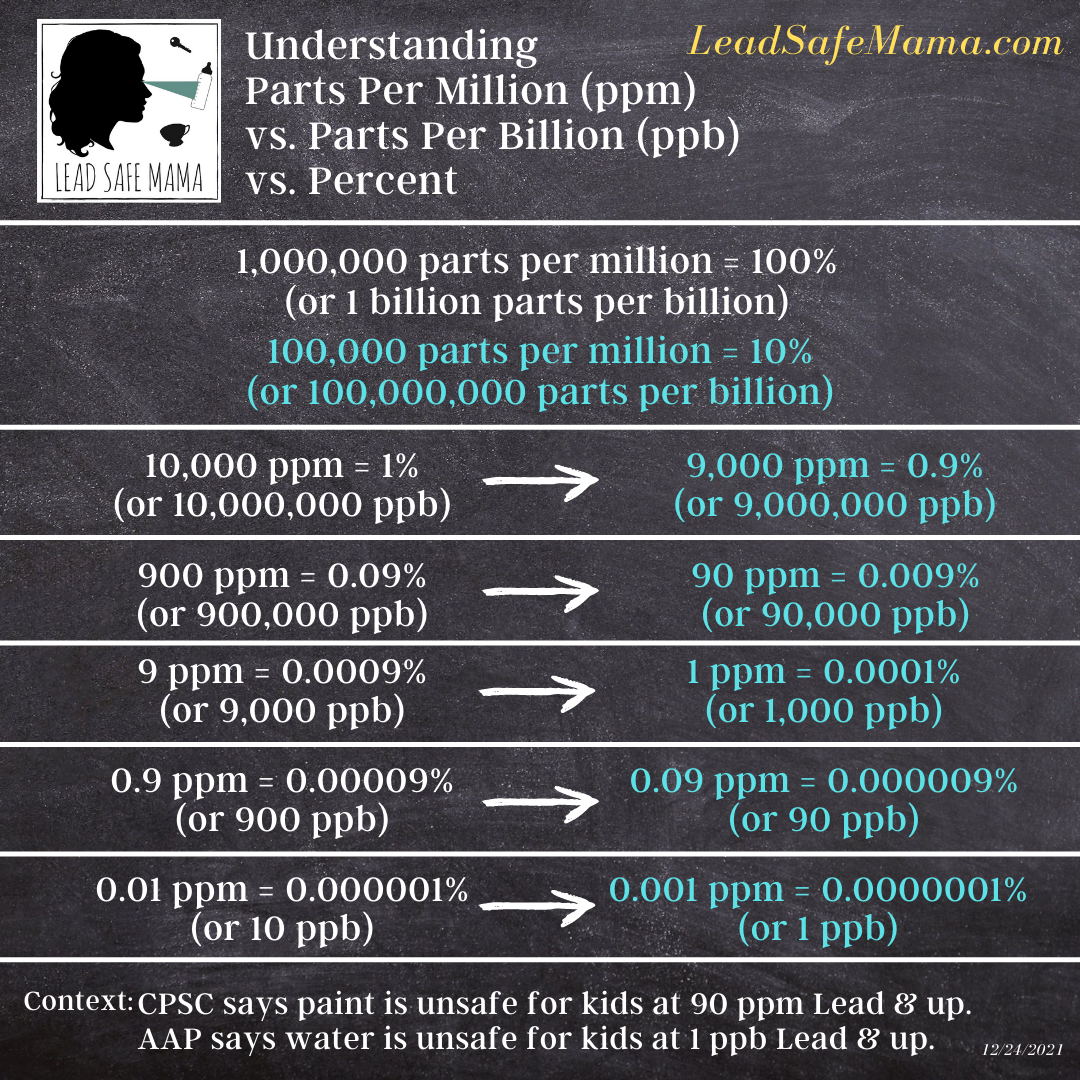Understanding ppm vs. ppb vs. percent — what do the terms “parts per million,” and “parts per billion” mean?
For those new to this website:
Tamara Rubin is a multiple-federal-award-winning independent advocate for childhood Lead poisoning prevention and consumer goods safety, and a documentary filmmaker. She is also a mother of Lead-poisoned children (two of her sons were acutely Lead-poisoned in 2005). Since 2009, Tamara has been using XRF technology (a scientific method used by the U.S. Consumer Product Safety Commission) to test consumer goods for toxicants (specifically heavy metals — including Lead, Cadmium, Mercury, Antimony, and Arsenic). All test results reported on this website are science-based, accurate, and replicable. Items are tested multiple times to confirm the test results for each component tested. Tamara’s work was featured in Consumer Reports Magazine in February of 2023 (March 2023 print edition).
December 24, 2021
I get asked some version of this question quite often:
- What does parts per million mean?
- What does parts per billion mean?
- How much is that as a percentage?
- How many grams or milligrams or micrograms of Lead does a certain amount of ppm convert to?
I created the quick reference graphic below to help my readers better understand these numbers.
PPM or PPB are terms that express concentrations, not specific quantitative measurements of exactly how much of a substance (like Lead) by weight, volume, or other metric is in some specific item/ object or supplement, measurements in ppm and ppb are a way to more specifically state a percentage. Said another away (as an example): If a supplement company provides you with a Product Data Sheet that shares how much Lead is in their product in the form of a number like “10 ppb Lead,” that information alone does not tell you how much Lead you will be ingesting when you take the recommended dose of that supplement; you need more information to make that determination (other data — like the total amount of material in question in the pill and the quantity of pills in a dose — is required for those determinations and that will be discussed in a separate article).
This does not mean that the ppm and ppb guidelines don’t have value or provide context. They do…
Regulatory limits (for water, food, candy, paint, etc.) are determined using science — based on how much Lead (or other specific/ regulated heavy metal) a person (or in many cases, specifically, a child) will likely be exposed to, given the anticipated potential exposure pathway, and the anticipated amount of that item a person might ingest or inhale when the item is used (or consumed) in the manner (and quantities) that are normally expected or intended for the product (toy, supplement, food, etc.) in question.
That said, I wanted to create this graphic so folks could better understand the distinctions “ppb” and “ppm,” as percentages — given those numbers are referenced so often on this website. I also wanted people to understand the orders of magnitude in range between — for example — the CPSC’s regulatory threshold for determining paint on a toy as toxic (90 ppm Lead) as it compares to the amount of Lead that is considered (by the American Academy of Pediatrics) toxic in water, for instance, (which is 1 ppb Lead and up).
Here’s the graphic:
Never Miss an Important Article Again!
Join our Email List










Those regulatory decisions are not made by science, they are strictly economic. The political system that sets these standards is highly politicized and many of the standards have not been updated in decades, This is why we are having to continually sue the USEPA to set new standards. They won’t update the standards like they are supposed to and when we finally get them to do it, the standards are not protective of of our kids and we have to sue them again.
Very frustrating!
But, no, not scientific. Political!
That’s basically the argument of my movie in a nutshell. Have you seen my film? Here’s a private preview screener link:
Lead (Pb): 638 +/- 37 ppm
What does this mean? Is this dinnerware safe for children or not. It looks like there’s negative lead (-37ppm).
Thanks in advance for any explanation you can provide.
It means that if it were sold today as an item intended for use by children it would not be considered safe by children. But dishes are not sold as items intended for use by children (are not regulated as items intended for use by children). 638 plus or minus 37 – means the range is 631 ppm to 675 ppm Lead.